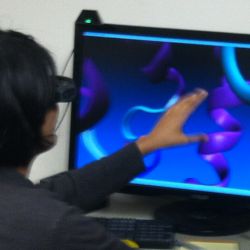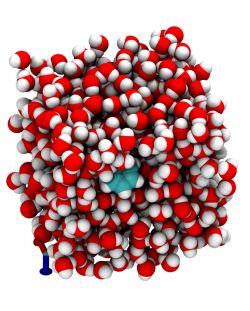
BioXFEL BioVizSim Village: Experiencing Molecules
All living organisms consist of molecules such as proteins or DNA. In order to understand how life works at the fundamental level we study these molecules and their interactions but this requires knowing their three-dimensional structure, their “blue print”. One of the goals of the BioXFEL Science and Technology Center is to experimentally obtain structures of biomolecules, their form and shape and in fact, the positions of all atoms that make up these molecules. However, proteins are dynamic entities and their function is largely determined by their dynamical movements and shape changes.
As part of the BioXFEL outreach program at ASU (lead by the PRIME Center ), three highschool students and one undergraduate student worked in the Lab in the “BioVizSim Village” for ten days on the Experiencing Molecules Project. In this project, students were immersed in the lab and learned how the static structural information obtained by XFEL/X-ray crystallography can serve as a starting point for computer simulations that can reveal the dynamical behavior of the biomolecules.
The goals of the project were to
- learn to work in a scientific computing environment
- learn to perform molecular dynamics (MD) simulations of proteins
- learn to visualize results from MD simulations
- build a virtual reality computer workstation that enables users to see molecules in 3D and even touch them and interact with them.
- communicate their results and experiences to a general audience
Participants and mentors of the Experiencing Molecules project: Kacey, Sean (Mentor), Rebecca, Yifan, Ushrayinee, Ian (Mentor)
The four participants Kacey, Rebecca, Ushrayinee (all high school students from the Phoenix area) and Yifan (undergraduate at ASU) were mentored by undergraduate student Ian Kenney and graduate student Sean Seyler (see picture) together with PI Oliver Beckstein. Participants and mentors met for nine consecutive mornings at the beginning of June 2015.

The mentors for the 2015 BioVizSim Village were graduate student Sean Seyler (left) and undergraduate student Ian Kenney (right), who are shown giving a tutorial on visualization.
Ian started with an introductory tutorial on using Linux and the command line (as the basis for any work in scientific computing) on the first day. Sean gave an introduction to visualization of biomolecules with the VMD software and molecular dynamics simulations of the enzyme adenylate kinase with the Gromacs package. Not everyone has a laptop available that runs Linux so we prepared a bootable Linux system with VMD and Gromacs on USB flash drives. Participants could simply boot from the flash drive on their own laptop (or one provided for the tutorials) and run Ubuntu Linux 14.04 LTS without having to install Linux themselves.
On the third day, students began working on building a “computational instrument”, a fast workstation that should combine 3D visualization capabilities with force-feedback through a haptic device.
3D glasses (NVIDIA 3D Vision 2) together with a NVIDIA Quadro K4000 graphics card and a ASUS VG278HE Black 27” monitor were combined with the stereoscopic capabilities of VMD to provide very convincing 3D visualization. However, it proved impossible to get the set-up to run under Linux (the 3D glasses were never activated) even though it is “supposed to work”. As an alternative, we installed Windows 7 and ran the Windows version of VMD.
The 3D Systems Geomagic Touch haptic device provides force feedback and in the past users had reported success in interfacing it with VMD and MD simulations through the use of VPRN. The Geomagic Touch is supposed to work under Ubuntu Linux 14.04 LTS but we never got it to be recognized so again, we switched to Windows 7. We managed to get VPRN to talk to the haptics but it turned out that the current Windows build of VMD is compiled against an older version of VPRN so we’ll have to wait for a new build to complete the project.
Students ran MD simulations of an ion or benzene molecule in water, of the enzyme galectin-3, and a carbon nanotube oscillator. On the last day, the students from all Villages presented their work and experiences at the Show Case. The BioVizSim group showed as a demonstration a running MD simulation with the 3D glasses (to much oooing and aaaing of the audience, who could all put on 3D glasses) and also demonstrated simple examples with the haptic device (the “spongy cow” was a general favorite…).
Overall, the students learned the first steps to do research in computational biophysics and also realized how hard it is in research to get something to work that “should just work”. A somewhat surprising insight was that debugging computer problems is just another application of hypothesis-driven research: If something does not work one formulates a hypothesis (after much googling and reading of endless man pages and forum posts…), carries out specific changes that ought to affect the behavior of the systems, observes closely (reads through debugging output), and adapts one’s hypothesis as necessary to be consistent with the data, until one understands where exactly the problem lies.





Discuss: “BioXFEL BioVizSim Village: Experiencing Molecules”